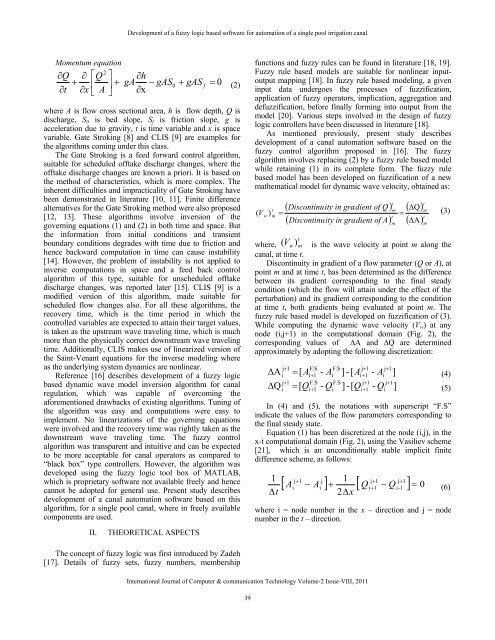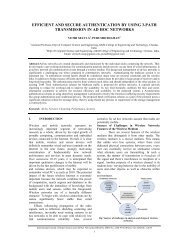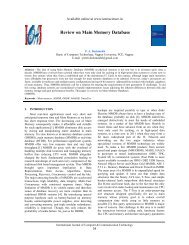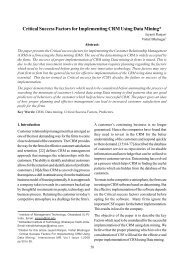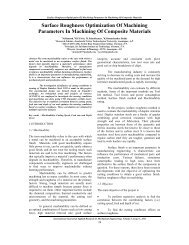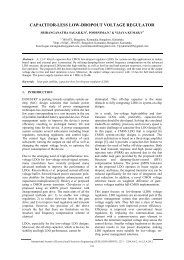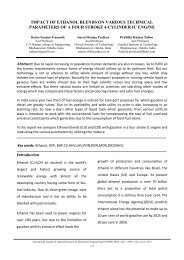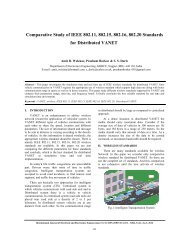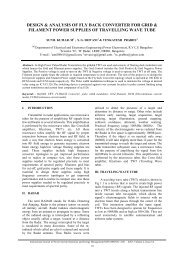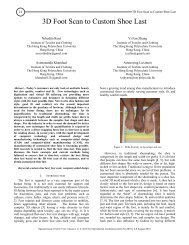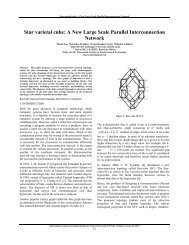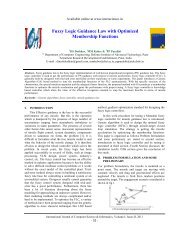Development of a fuzzy logic based software for automation of a ...
Development of a fuzzy logic based software for automation of a ...
Development of a fuzzy logic based software for automation of a ...
You also want an ePaper? Increase the reach of your titles
YUMPU automatically turns print PDFs into web optimized ePapers that Google loves.
<strong>Development</strong> <strong>of</strong> a <strong>fuzzy</strong> <strong>logic</strong> <strong>based</strong> s<strong>of</strong>tware <strong>for</strong> <strong>automation</strong> <strong>of</strong> a single pool irrigation canalMomentum equation∂Q+∂t2⎡Q⎤ ∂h⎢ ⎥ + gA − gAS0x ⎣ A ⎦ ∂x∂∂+ gAS f= 0where A is flow cross sectional area, h is flow depth, Q isdischarge, S 0 is bed slope, S f is friction slope, g isacceleration due to gravity, t is time variable and x is spacevariable. Gate Stroking [8] and CLIS [9] are examples <strong>for</strong>the algorithms coming under this class.The Gate Stroking is a feed <strong>for</strong>ward control algorithm,suitable <strong>for</strong> scheduled <strong>of</strong>ftake discharge changes, where the<strong>of</strong>ftake discharge changes are known a priori. It is <strong>based</strong> onthe method <strong>of</strong> characteristics, which is more complex. Theinherent difficulties and impracticality <strong>of</strong> Gate Stroking havebeen demonstrated in literature [10, 11]. Finite differencealternatives <strong>for</strong> the Gate Stroking method were also proposed[12, 13]. These algorithms involve inversion <strong>of</strong> thegoverning equations (1) and (2) in both time and space. Butthe in<strong>for</strong>mation from initial conditions and transientboundary conditions degrades with time due to friction andhence backward computation in time can cause instability[14]. However, the problem <strong>of</strong> instability is not applied toinverse computations in space and a feed back controlalgorithm <strong>of</strong> this type, suitable <strong>for</strong> unscheduled <strong>of</strong>ftakedischarge changes, was reported later [15]. CLIS [9] is amodified version <strong>of</strong> this algorithm, made suitable <strong>for</strong>scheduled flow changes also. For all these algorithms, therecovery time, which is the time period in which thecontrolled variables are expected to attain their target values,is taken as the upstream wave traveling time, which is muchmore than the physically correct downstream wave travelingtime. Additionally, CLIS makes use <strong>of</strong> linearized version <strong>of</strong>the Saint-Venant equations <strong>for</strong> the inverse modeling whereas the underlying system dynamics are nonlinear.Reference [16] describes development <strong>of</strong> a <strong>fuzzy</strong> <strong>logic</strong><strong>based</strong> dynamic wave model inversion algorithm <strong>for</strong> canalregulation, which was capable <strong>of</strong> overcoming thea<strong>for</strong>ementioned drawbacks <strong>of</strong> existing algorithms. Tuning <strong>of</strong>the algorithm was easy and computations were easy toimplement. No linearizations <strong>of</strong> the governing equationswere involved and the recovery time was rightly taken as thedownstream wave traveling time. The <strong>fuzzy</strong> controlalgorithm was transparent and intuitive and can be expectedto be more acceptable <strong>for</strong> canal operators as compared to“black box” type controllers. However, the algorithm wasdeveloped using the <strong>fuzzy</strong> <strong>logic</strong> tool box <strong>of</strong> MATLAB,which is proprietary s<strong>of</strong>tware not available freely and hencecannot be adopted <strong>for</strong> general use. Present study describesdevelopment <strong>of</strong> a canal <strong>automation</strong> s<strong>of</strong>tware <strong>based</strong> on thisalgorithm, <strong>for</strong> a single pool canal, where in freely availablecomponents are used.II.THEORETICAL ASPECTS(2)functions and <strong>fuzzy</strong> rules can be found in literature [18, 19].Fuzzy rule <strong>based</strong> models are suitable <strong>for</strong> nonlinear inputoutputmapping [18]. In <strong>fuzzy</strong> rule <strong>based</strong> modeling, a giveninput data undergoes the processes <strong>of</strong> fuzzification,application <strong>of</strong> <strong>fuzzy</strong> operators, implication, aggregation anddefuzzification, be<strong>for</strong>e finally <strong>for</strong>ming into output from themodel [20]. Various steps involved in the design <strong>of</strong> <strong>fuzzy</strong><strong>logic</strong> controllers have been discussed in literature [18].As mentioned previously, present study describesdevelopment <strong>of</strong> a canal <strong>automation</strong> s<strong>of</strong>tware <strong>based</strong> on the<strong>fuzzy</strong> control algorithm proposed in [16]. The <strong>fuzzy</strong>algorithm involves replacing (2) by a <strong>fuzzy</strong> rule <strong>based</strong> modelwhile retaining (1) in its complete <strong>for</strong>m. The <strong>fuzzy</strong> rule<strong>based</strong> model has been developed on fuzzification <strong>of</strong> a newmathematical model <strong>for</strong> dynamic wave velocity, obtained as:t( Discontinuity in gradient <strong>of</strong> Q )t( Discontinuity in gradient <strong>of</strong> A)t( ΔQ)( ΔA)tmm( Vw)m= = (3)twhere, ( V ) t w m is the wave velocity at point m along thecanal, at time t.Discontinuity in gradient <strong>of</strong> a flow parameter (Q or A), atpoint m and at time t, has been determined as the differencebetween its gradient corresponding to the final steadycondition (which the flow will attain under the effect <strong>of</strong> theperturbation) and its gradient corresponding to the conditionat time t, both gradients being evaluated at point m. The<strong>fuzzy</strong> rule <strong>based</strong> model is developed on fuzzification <strong>of</strong> (3).While computing the dynamic wave velocity (V w ) at anynode (i,j+1) in the computational domain (Fig. 2), thecorresponding values <strong>of</strong> ∆A and ∆Q are determinedapproximately by adopting the following discretization:ΔAΔQj + 1i=j + 1i=F.S F.S j+1 j+1[ Ai+1- Ai] -[ Ai+ 1- Ai](4)F.S F.S j+1 j+1[ Q - Q ] -[ Q - Q ](5)i+1ii+1In (4) and (5), the notations with superscript “F.S”indicate the values <strong>of</strong> the flow parameters corresponding tothe final steady state.Equation (1) has been discretized at the node (i,j), in thex-t computational domain (Fig. 2), using the Vasiliev scheme[21], which is an unconditionally stable implicit finitedifference scheme, as follows:j+1 j 1 j+1 j+[ A − A ] + [ Q − Q ] 01 1i ii+1 i-1=Δt2Δxwhere i = node number in the x – direction and j = nodenumber in the t – direction.imm(6)The concept <strong>of</strong> <strong>fuzzy</strong> <strong>logic</strong> was first introduced by Zadeh[17]. Details <strong>of</strong> <strong>fuzzy</strong> sets, <strong>fuzzy</strong> numbers, membershipInternational Journal <strong>of</strong> Computer & communication Technology Volume-2 Issue-VIII, 201139


